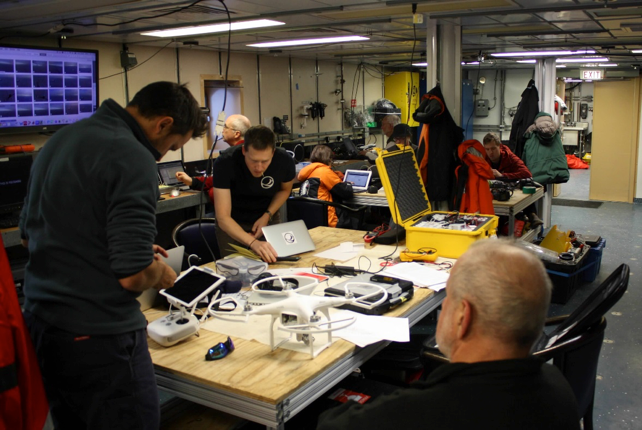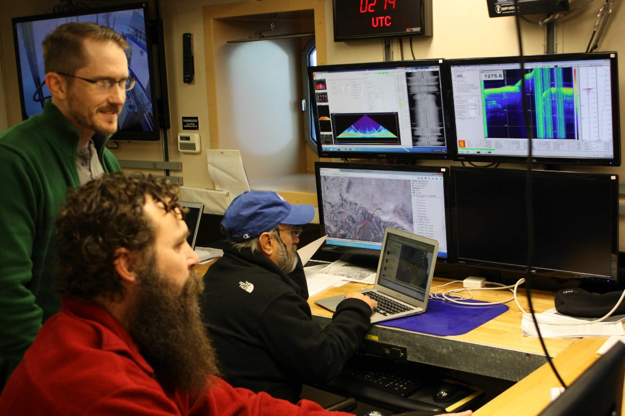By Ola Persson
The Main level of the ship is where the science workplaces are on the ship. These rooms are the Main Lab, the Computer Lab, the Wet Lab, the Baltic Room, and the Main deck. People who need to have access to visual displays of products from the internet connection sit in the Computer Lab. This includes Erick, who forecasts the upcoming wave conditions, and Ben who interprets images from the synthetic aperture radar (SAR) images from satellites to identify the ice conditions. Erick receives wind and ice forecasts from Navy colleagues at Stennis in Mississippi to run a wave model on board the ship. Teams at the University of Victoria and Bedford Institute of Oceanography, on the opposite coasts of Canada, send SAR images daily. To help him make daily weather forecasts, particularly for wind and temperature conditions, Ola receives tailored daily operational and experimental output from the European Center for Medium Range Weather Forecasting and from the Physical Sciences Division of NOAA/ESRL. All of these products get channeled through a server at the University of Victoria. Sharon also monitors the results of upper-ocean temperature and salinity sampling in this room. A large bank of monitors in this room provides chief scientist Jim Thomson of the University of Washington an overview of project operations.
Data being collected by a variety of instruments all over the ship are funneled into the Main Lab, where they are monitored by the various research groups and recorded on a number of different computers. These include the flux, radiation and meteorological data being collected by NOAA/PSD/CIRES from instruments on the bow mast and on top of the ship’s bridge, stereo imagery being collected from cameras on both sides of the ship at the bridge level, and the preparation of radiosondes and receiving the radiosonde data as it comes in from the weather balloons. The Main Lab also provides bench space for preparing and repairing various autonomous instruments, such as fixed-wing and quadcopter unmanned aerial systems (UAS). It’s also where the daily science meeting is held and directed by Jim Thomson. Aft of the Main Lab is the Wet Lab where the on-ice and buoy operations are prepared. One room further aft is the Baltic Room, which is the key indoor staging area, where buoys, the autonomous underwater vehicle, and the weather balloons are all prepped before being taken out and launched from the main deck on the rear of the ship.

Guy, Byron, Jim, Alison, Steve (foreground); Bob Joe, and Alex (background) working on their various tasks in the Main Lab.
On the Main Deck, there is a 20′ long container that houses the ice survey data acquisition system that makes continuous measurements of ice thickness and infrared temperature along the side of the ship from a pod suspended from the ship’s crane. All operations that need access to the ice or water are done from this main deck. This includes launching and recovering buoys and the automated underwater system, the underway profiles of upper-ocean temperature and salinity, using “man-baskets” suspended by the cranes to put people on the ice, using dip nets to get ice samples, launching weather balloons, and some launches of the UAS.
While the various instruments collecting data are located throughout and all over the ship, the heart of the science operations is located on this main level of the ship. There are always people working there throughout all hours of the day.


